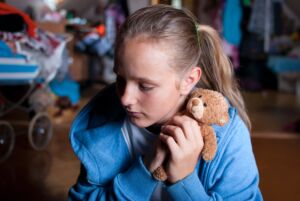Body image refers to how you think about your body and feel about the way you look. It influences the way you engage with the world and can have a significant impact on your mental health, self-esteem, and overall sense of well-being.
 Children with a positive body image tend to be comfortable with their bodies, to have more confidence in themselves, and to engage in healthy lifestyle choices such as a balanced approach to food and physical activity.
Children with a positive body image tend to be comfortable with their bodies, to have more confidence in themselves, and to engage in healthy lifestyle choices such as a balanced approach to food and physical activity.
Children with a negative body image, on the other hand, tend to be self-conscious, self-critical, unhappy about their appearance, and to focus only on their flaws. They are also at greater risk for excessive weight gain and eating disorders down the road.
Studies indicate that attitudes about body shape and size are formed at an early age, and children as young as three years old have already been known to have concerns about their body image.
Although a child’s body image is influenced by many things, parents are their most influential role models. Parents can play a crucial role in helping their child build a healthy view of themselves by showing him or her how it is done and setting an example by the way they talk about and treat their own bodies. Irvine Christian Counseling can offer support to parents in fostering positive body image in their children.
Signs that your child may have body image issues.
- Saying negative things about parts of their body they don’t like.
- Comparing their body to others.
- Worrying about what other children may say or think about what they look like.
- Talking about dieting, not finishing meals, or cutting out treats.
- Feeling guilty or self-critical after eating something they usually enjoy.
How to help your child develop a healthy body image.
Be a role model for your child.
Reflect on your relationship with your own body and what messages you may be sending your child. Watch the words you speak. Boosting your child’s image of their body starts with boosting your own. Talk about and treat your body the way you would like your child to talk about and treat his or her body.
Try to model a healthy acceptance of your own body shape and size, and avoid negative body talk about body parts you are unhappy with, or about wanting to change the way you look through dieting or grueling workouts.
Validate your child’s concerns.
Encourage your child to talk to you about what he or she thinks and feels about his or her body and validate any concerns he or she may have. Motivate them to be happy with their body by teaching them that bodies come in all shapes and sizes and that all bodies are good bodies.
Encourage your child to celebrate body diversity and embrace their uniqueness. If you avoid placing too much value on physical appearance, your child will as well.
Teach your child to be media savvy.
Avoid comparing your body and what you look like to others, and encourage your child to do the same. Teach him or her to be critical of images on social media and in ads that promote body ideals such as thinness or muscularity, and to question and challenge society’s narrow ideals of beauty.
Promote healthy eating.
Avoid labeling foods as good or bad. Focus instead on its nutritional value and on making healthy choices to fuel your body. Instead of indulging in fad dieting, encourage intuitive eating and instruct your child about balancing what they eat rather than restricting food.
 Make physical activity fun.
Make physical activity fun.
Encourage your child to be physically active and engage in regular physical activity for its health benefits and for fun rather than for weight management. Engage in physical activity yourself, and encourage your child to join in and be active with you.
Celebrate non-physical attributes.
Talk to your child about all the things that make up a person, such as personality and talents. Encourage him or her to appreciate what his or her body can do rather than focus on what it looks like.
Look for opportunities to compliment your child for positive behaviors such as being thoughtful, kind, generous, and polite, rather than just on how nice they look. This will help them learn that good character is much more important and help boost their self-esteem.
If you have questions about this article or would like to set up an appointment to meet with one of the counselors at Irvine Christian Counseling, please don’t hesitate to give us a call.
References:
“Body image: pre-teens and teenagers. raisingchildren.net.au. raisingchildren.net.au/pre-teens/healthy-lifestyle/body-image/body-image-teens.
familydoctor.org editorial staff. “Body Image (Children and Teens).” familydoctor.org. Updated June 2023. familydoctor.org/building-your-childs-body-image-and-self-esteem/.
Mott Poll Report. “Parents’ perception of their child’s body image.” C.S. Mott Children’s Hospital. September 19, 2022. mottpoll.org/reports/parents-perception-their-childs-body-image.
“Tackling Body Image Issues in Children.” bestchance Child Family Care. bestchance.org.au/blog/tackling-body-image-issues-in-children/.
Photos:
“Snack Time”, Courtesy of Getty Images, Unsplash.com, Unsplash+ License; “Friends on the Beach”, Courtesy of Natalia Blauth, Unsplash.com, Unsplash+ License; “Girl and Bear”, Courtesy of Getty Images, Unsplash.com, Unsplash+ License
-
Sandra Stein: Author
Sandra Kovacs Stein was born in Calcutta, India, grew up in the Dominican Republic, and went to school in Canada, where she planned to settle after getting her Master’s degree in Speech Pathology and Audiology. Instead, she fell in love with an Ameri...
DISCLAIMER: THIS ARTICLE DOES NOT PROVIDE MEDICAL ADVICE
Articles are intended for informational purposes only and do not constitute medical advice; the Content is not intended to be a substitute for professional medical advice, diagnosis, or treatment. All opinions expressed by authors and quoted sources are their own and do not necessarily reflect the opinions of the editors, publishers or editorial boards of Irvine Christian Counseling. This website does not recommend or endorse any specific tests, physicians, products, procedures, opinions, or other information that may be mentioned on the Site. Reliance on any information provided by this website is solely at your own risk.






